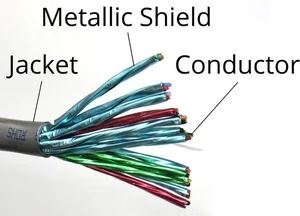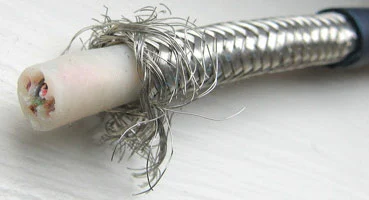Knowing when to use shielded cable is really a matter of knowing the work environment in which the cable is intended for. Depending upon the application, shielded cable may be necessary to keep a product or device functioning correctly!
What is Shielded Cable?
 A shielded cable contains normal insulating conductors enclosed in a standard conductive layer with a special protective shield layer. This shield layer is what sets these cables apart from normal non-shielded variants. Shields are wrapped around the insulated conductors and are generally made from:
A shielded cable contains normal insulating conductors enclosed in a standard conductive layer with a special protective shield layer. This shield layer is what sets these cables apart from normal non-shielded variants. Shields are wrapped around the insulated conductors and are generally made from:
- Strands of braided copper and similar metals
- Spiral copper tape
- Conducting polymers
What do Shielded Cables Do?
Shielded cables reduce and insulates the transfer of data or power from ‘electrical noise’ or ambient electromagnetic interference (EMI) found in industrial, engineering, or manufacturing environments where a high degree of electrical power is present, and data and power transfer is subject to electronic interference.
What is Electromagnetic Inerference (EMI)?
EMI is the variable electrical currents and voltages regularly occurring in the environment. We recognize it as the common interference that disrupts such things as cell phones, televisions, or AM radio. It can be natural, inherent, or manmade.
Naturally-occurring EMI can be caused by thunder and lightning storms, snow storms, rain particles, and solar radiation. Natural EMI causes fewer problems with modern digital equipment than older data links and radio frequency communications via ship, shore, and air.
Inherent EMI is the electrical noise produced within electronic equipment. Thermal agitation of electrons that flow through circuit resistance creates ‘white noise,’ most often associated with that familiar sound of a radio receiver’s frequency between stations.
Manmade EMI is caused by different classes of electrical and electronic equipment. Vehicle ignitions, motors, transmitters, generators, power lines, mobile phones, types of lighting, and the like are all examples of manmade devices that can cause EMI degradation in power delivery systems and data processing equipment.
When to Use Unshielded Cables
Aside from the physical differences between shielded vs unshielded cables and how that affects the way they are able to be implemented, there are certain situations where shielded cables are necessary for a device or product to function correctly. Although unshielded cables have twisted pair of wires acts to cancel out low-level EMI emittance, they are not suited for industrial environments where large amounts of power are used or needed. Instead, unshielded cables are usually used:
- Indoors (primarily in local area networks)
- Local cable networks in moderate sized offices, small businesses, and homes
- Controlled industrial environments where the cable can be housed in metal conduits or cabinets
When to Use Shielded Cables
Unlike unshielded cables, shielded cables are used to protect power and data paths from degradation caused by EMI exposure during power and data transfer. Electrical noise and EMI affects electrical circuits via electrostatic coupling, conduction, or electromagnetic induction. That disturbance interferes with the performance of circuits, and in some cases can prevent its functioning properly or at all. Wherever a data path exists, these effects can vary from increased error rates to a complete loss of data.
Shielded cable acts to reduce volume and intensity of all kinds of electrical noise and EMI, along with the adverse effects it has on signals and transmission.
- Heavy industrial settings (manufacturing plants, large data centers, etc)
- Airports
- Radio stations
- Consumer electronics like televisions and cell phones
 Whether radiated or conducted, EMI can seriously disrupt the proper operation of other equipment. The insulation around unshielded cables protects it from scrapes, abrasions, spills and environmental moisture, but offers no protection from EMI. Ironically, the cables themselves are a source of EMI. The wiring conducts noise or can function as an antenna which radiates noise, and also pick up noise radiated from electronic sources around it.
Whether radiated or conducted, EMI can seriously disrupt the proper operation of other equipment. The insulation around unshielded cables protects it from scrapes, abrasions, spills and environmental moisture, but offers no protection from EMI. Ironically, the cables themselves are a source of EMI. The wiring conducts noise or can function as an antenna which radiates noise, and also pick up noise radiated from electronic sources around it.
Shielded cable is necessary to reduce and prevent all the effects of EMI and the other hazards found in busy, industrial workplaces. The shield reflects energy and grounds electrical noise by surrounding the power-carrying conductors or inner signals. The energy that does pass through or is emitted is so highly attenuated it does not cause interference.
Need help designing a cable assembly or wire harness?
JEM Electronics is a leading contract manufacturer of custom cable assemblies and wire harnesses with over 30 years of experience. We have the knowledge and expertise to help you with both shielded and unshielded cable specs!


